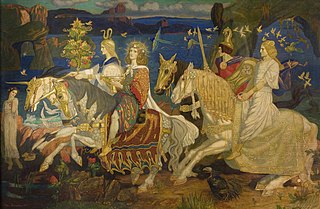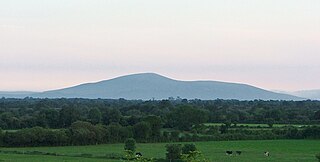Related Research Articles

Irish mythology is the body of myths indigenous to the island of Ireland. It was originally passed down orally in the prehistoric era. In the early medieval era, some myths were transcribed by Christian monks, who heavily altered and Christianised the myths. Irish mythology is the best-preserved branch of Celtic mythology.

Fionn mac Cumhaill, often anglicized Finn McCool or MacCool, is a hero in Irish mythology, as well as in later Scottish and Manx folklore. He is the leader of the Fianna bands of young roving hunter-warriors, as well as being a seer and poet. He is said to have a magic thumb that bestows him with great wisdom. He is often depicted hunting with his hounds Bran and Sceólang, and fighting with his spear and sword. The tales of Fionn and his fiann form the Fianna Cycle or Fenian Cycle, much of it narrated by Fionn's son, the poet Oisín.
Cormac mac Airt, also known as Cormac ua Cuinn or Cormac Ulfada, was, according to medieval Irish legend and historical tradition, a High King of Ireland. He is probably the most famous of the ancient High Kings, and may have been an authentic historical figure, although many legends have attached themselves to him, and his reign is variously dated as early as the 2nd century and as late as the 4th. He is said to have ruled from Tara, the seat of the High Kings of Ireland, for forty years, and under his rule, Tara flourished. He is credited for building many of the monuments at the Hill of Tara such as the Banqueting Hall, Cormac's house, and Gráinne's Enclosure, named after his daughter. He was famous for his wise, true, and generous judgments. In the Annals of Clonmacnoise, translated in 1627, he is described as:
"absolutely the best king that ever reigned in Ireland before himself...wise learned, valiant and mild, not given causelessly to be bloody as many of his ancestors were, he reigned majestically and magnificently".

Diarmuid Ua Duibhne, also known as Diarmuid of the Love Spot, was a hero and demigod, son of Donn and one of the Fianna in the Fenian Cycle of Irish mythology. He is best known as the lover of Gráinne, the intended wife of Fianna leader Fionn mac Cumhaill in the legend The Pursuit of Diarmuid and Gráinne. Among his sons were Donnchadh, Iollann, Ruchladh and Ioruad.

Fianna were small warrior-hunter bands in Gaelic Ireland during the Iron Age and early Middle Ages. A fian was made up of freeborn young males, often from the Gaelic nobility of Ireland, "who had left fosterage but had not yet inherited the property needed to settle down as full landowning members of the túath". For most of the year they lived in the wild, hunting, cattle raiding other Irish clans, training, and fighting as mercenaries. Scholars believe the fian was a rite of passage into manhood, and have linked fianna with similar young warrior bands in other early European cultures.
Goll mac Morna was a member of the fianna and an uneasy ally of Fionn mac Cumhail in the Fenian Cycle of Irish mythology. He had killed Fionn's father, Cumhal, and taken over the leadership of the fianna, but when Fionn grew up and proved his worth Goll willingly stepped aside in his favour.
Cumhall or Cumhall mac Trénmhoir is a figure in the Fenian Cycle of Irish mythology, a leader of the fianna and the father of Fionn mac Cumhaill.

Niamh or Niaṁ is the lover or spouse of Oisín, son of Fionn mac Cumhail, in the Fianna Cycle of Irish mythology.

The Fenian Cycle, Fianna Cycle or Finn Cycle is a body of early Irish literature focusing on the exploits of the mythical hero Finn or Fionn mac Cumhaill and his warrior band the Fianna. Sometimes called the Ossianic Cycle after its narrator Oisín, it is one of the four groupings of Irish mythology along with the Mythological Cycle, the Ulster Cycle, and the Kings' Cycles. Timewise, the Fenian cycle is the third, between the Ulster and Kings' cycles. The cycle also contains stories about other famous Fianna members, including Diarmuid, Caílte, Oisín's son Oscar, and Fionn's rival Goll mac Morna.

Oisín, Osian, Ossian, or anglicized as Osheen was regarded in legend as the greatest poet of Ireland, a warrior of the Fianna in the Ossianic or Fenian Cycle of Irish mythology. He is the demigod son of Fionn mac Cumhaill and of Sadhbh, and is the narrator of much of the cycle and composition of the poems are attributed to him.
Cairbre Lifechair, son of Cormac mac Airt, was, according to medieval Irish legend and historical tradition, a High King of Ireland. He came to the throne after the death of Eochaid Gonnat. During his time Bresal Belach was king of Leinster, and refused to pay the bórama or cow-tribute to the High King, but Cairbre defeated him in the Battle of Dubchomar, and from then on exacted the bórama without a battle.
Caíltemac Rónáin was a nephew of Fionn mac Cumhaill, a warrior and a member of the fianna in the Fenian Cycle of Irish mythology. He is described as being able to run at remarkable speed and communicate with animals, and was a great storyteller. Some poems of the Fenian Cycle are attributed to Caílte.

Slievenamon or Slievenaman is a mountain with a height of 721 metres (2,365 ft) in County Tipperary, Ireland. It rises from a plain that includes the towns of Fethard, Clonmel and Carrick-on-Suir. The mountain is steeped in folklore and is associated with Fionn mac Cumhaill. On its summit are the remains of ancient burial cairns, which were seen as portals to the Otherworld. Much of its lower slopes are wooded, and formerly most of the mountain was covered in woodland. A low hill attached to Slievenamon, Carrigmaclear, was the site of a battle during the Irish Rebellion of 1798.
Oscar is a figure in the Fenian Cycle of Irish mythology. He is the son of Oisín and Niamh, and the brother of Plor na mBan and Finn, his bride is called Malvina. Though possibly a later addition to the cycle, Oscar was a popular character, and appeared prominently in several later Fenian tales, serving his grandfather as one of the fianna.

Acallam na Senórach, is an important prosimetric Middle Irish narrative dating to c. 1200. It is the most important text of the Finn Cycle and at about 8,000 lines is the longest-surviving work of medieval Irish literature. It contains many Finn Cycle narratives framed by a story in which the fianna warriors and Caílte mac Rónáin have survived long enough to relate the tales to Saint Patrick. The work has been seen as a defence of the Irish literary establishment when it came under the scrutiny of Church reformers during the 12th to 13th centuries.

The Pursuit of Diarmuid and Gráinne is an Irish prose narrative surviving in many variants. A tale from the Fianna Cycle of Irish mythology, it concerns a love triangle between the great warrior Fionn mac Cumhaill, the beautiful princess Gráinne, and her paramour Diarmuid Ua Duibhne. Surviving texts are all in Modern Irish and the earliest dates to the 16th century, but some elements of the material date as far back as the 10th century.
Acallam Bec or Agallamh Bheag is the title of a medieval Irish compilation of fianaigecht tales, preserved in the fifteenth-century Book of Lismore and the Reeves manuscript. It is closely related to the Acallam na Senórach, of which it is sometimes considered to be a later recension. It differs from it in making Oisín rather than Caílte the principal character. Douglas Hyde has suggested that the text may preserve the lost beginning of Acallam na Senórach.

Cath Finntrágha is an Early Modern Irish prose narrative of the Finn Cycle of Irish mythology. It dates probably to the 15th century in its current form, but apparently relied on older material. It concerns the deeds of the warrior-hero Finn mac Cumaill, his fianna, and, eventually, the gods and goddesses of Irish myth as they defend Ireland against a foreign invasion led by the world-king Dáire Donn. According to Derick Thomson, an 18th century manuscript of the story in the Scottish Gaelic language also survives in the hand of iconic Scottish war poet Alasdair Mac Mhaighstir Alasdair.
Failinis [FAW IHN-ish] or Ṡalinnis/Shalinnis is a dog in the Mythological Cycle of Irish literature, belonging to Lugh Lámhfhada of the Tuatha Dé Danann; it was one of the eric (reparation) items exacted from the sons of Tuireann.
References
- MacKillop, James (1998). Dictionary of Celtic Mythology. Oxford. ISBN 0-19-860967-1.
- O'Kearney, Nicholas, ed. (1854). The Battle of Gabhra: Garristown in the Country of Dublin, Fought A.D. 283. For the first time edited, from an original Irish manuscript, with introduction, literal translation, and notes. Transactions of the Ossianic Society. Vol. 1853 vol. 1. Dublin: John O'Daly for the Council of the Ossianic Society.